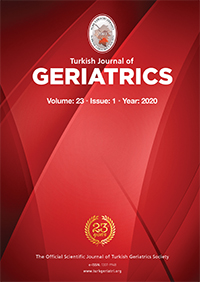2Health Sciences University, Izmir Bozyaka Training and Research Hospital, Biochemistry Department, Izmir, TURKEY DOI : 10.31086/tjgeri.2020.144 Introduction: Digoxin monitoring is important in the elderly because of the toxicity risk. The aim of this study was to evaluate the orders made by different units for digoxin monitoring in the elderly.
Materials and Method: Digoxin orders and results in patients aged over 65, patients" demographic characteristics, such as age and gender, the unit from which the order was made, and patients" pre-diagnoses were retrospectively recorded. Patients were divided into young-old, middle-old, and very-old groups, and the results were divided into subtherapeutic, therapeutic, and toxic levels.
Results: The percentage of young-old, middle-old, and very-old patients was 39.4%, 45.3%, and 15.3%, respectively. Women were more (64.3%) and their median age and digoxin concentrations were higher (p<0.001). Outpatients" median digoxin concentrations were lower than inpatients" median digoxin concentrations (p<0.001). A proportion of 46.6% of all digoxin levels were therapeutic; 29.2% were subtherapeutic; and 24.2% were toxic. Subtherapeutic levels in males and toxic levels in females predominated (p<0.001). Toxic levels were higher in inpatients, and subtherapeutic levels were higher in outpatients (p<0.001). The highest rate of therapeutic levels was observed in young-old patients (48.7%), while toxic levels were observed most frequently in very-old patients (28.1%). The highest number of digoxin orders in elderly patients was from the emergency department (44.2%).
Conclusion: In elderly patients, more than half of the serum digoxin orders were inappropriate. These results significantly changed according to gender, outpatient or inpatient status, age, and the ordering unit. Changes in digoxin pharmacokinetics, especially in the geriatric period, require physicians to be vigilant of subtherapeutic drug concentrations.
Keywords : Aged; Geriatrics; Digoxin; Drug monitoring
